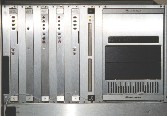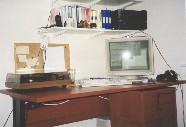 |
There are six computers running NetBSD
in this picture (although admittedly one isn't switched on). Sitting
on top of the wooden shelf is a 12 slot VME rack containing four Motorola
single board computers (two MVME147's, and two MVME167's)
running NetBSD/mvme68k.
These are the main development machines for NetBSD/mvme68k.
Below the rack on the upper white shelf, you can just see to the left (mounted vertically in a black-coloured box), a `Shark' Network Computer running NetBSD/arm32. This machine performs sterling service as an Internet firewall/NAT gateway/email gateway/inn news spool/Junkbuster proxy/time server/print server (for an Epson Stylus 640). On the floor is an APC SmartUPS-1000 Un-interruptible Power Supply, powering all the main computers in the "Lab". The UPS is monitored, via its serial port, by my main server (not in this picture) which is able to instruct, via the network, all the other affected computers to shutdown in the event of a prolonged power outage. To the right of the UPS is a MicroVAX-II. This was donated to me by David Brownlee, together with a bunch of QBUS cards and ST-506 disk drives (preloaded with NetBSD/vax). I plan on getting this up and running sometime soon ;-). |


